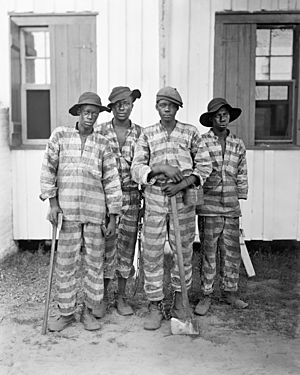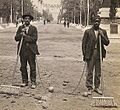Convict lease facts for kids
Convict leasing was a system of forced labor in the Southern United States. It happened after the end of slavery. In this system, prisons rented out prisoners to companies, business owners, and large farms. It was like selling prisoners for a short time, but not forever.
This system made a lot of money for both prisons and the businesses. Businesses got workers they didn't have to pay. Prisons received money from the businesses. Also, prisons didn't have to pay for food, clothes, or housing for these prisoners. The businesses paid for those things instead.
For example, in 1898, about 73% of Alabama's state income came from convict leasing. This is why the system lasted for almost 100 years in the South.
Contents
How it Started
The state of Louisiana began renting out prisoners as early as 1844. But convict leasing became common across the South during the Reconstruction Era (1865–1877). This was right after the American Civil War ended slavery.
After the war, Southern farmers and business owners needed new workers. So, Southern states passed laws called Black Codes. These laws made it hard for Black people to move freely. They also forced Black people to work for white people.
Historian Douglas Blackmon explained that these laws made many everyday things a crime for Black people. For example, it was a crime if someone couldn't prove they had a job. It was also against the law for Black Americans to sell their crops after dark. If someone broke these laws, they could be sent to prison for hard labor or fined a lot of money. Then, they were rented out to work on farms, in coal mines, or building railroads.
Southern states didn't have much money then. Convict labor became a big source of income for them. Businesses also made money because they didn't have to pay wages to these prisoners. The Thirteenth Amendment to the United States Constitution had made slavery illegal. But it said slavery was allowed as punishment for a crime. So, states passed laws that made it easy to convict innocent Black people of crimes. Once they were prisoners, they could be treated like slaves. This was a way for states to continue forced labor in the South.
Life for Prisoners
In the South, states gave businesses complete control over the prisoners they rented. Historian Matthew Mancini said the Southern convict labor system was "one of the harshest and most exploitative labor systems" in American history. Businesses often thought, "If one prisoner dies, get another." This happened because of corruption, racism, and because businesses could do whatever they wanted without getting into trouble.
Prisoners were often treated very badly. Businesses had not paid much for the prisoners. They also knew they wouldn't have them forever. So, they didn't care much about the prisoners' well-being. Prisoners could be beaten or whipped if their bosses thought they weren't working hard enough. They were abused by guards. Some reports say that mines and farms using convict laborers had secret graveyards. These contained bodies of prisoners who had been beaten or tortured to death.
Most of the prisoners who were rented out were African American men. This was because laws were used much more strictly against Black people. Black people usually received much harsher sentences for "crimes" due to racism.
U.S. Steel is one American company that has admitted using African-American leased convict labor.
Convict leasing was most common around 1880. The last state to formally outlaw it was Alabama in 1928. However, it continued in different ways until President Franklin D. Roosevelt made it illegal on December 12, 1941.
The System in Different States
Here are some examples of how convict leasing worked in different states:
| State | Started | Ended | Notes |
|---|---|---|---|
| Alabama | 1846 | 1928 | Death rates for leased prisoners in Alabama were 10 times higher than for prisoners in states that didn't lease them. |
| Georgia | 1868 | 1908 | Prisoners mostly worked on railroads. This system made a lot of money for the state and companies. |
| Florida | 1877 | 1923 | Prisoners often worked in turpentine factories and lumber camps. The system ended in 1923 after the Martin Tabert case. He was whipped 50 times and died for not doing his work. |
| Tennessee | 1866 | 1894 | In the Coal Creek War of 1891, free mine workers burned down prison camps. They freed hundreds of Black convict laborers. |
| Texas | 1883 | 1910 | Texas first rented out an entire prison. Later, it leased prisoners mostly to large farms. The state ended the system when it found it could make more money by buying its own farmland and making prisoners work there. |
After stopping convict leasing, many states used the trusty system. This also saved money but led to abuses. Finally, a federal court case called Gates v. Collier (1974) forced states to stop using the trusty system.
Impact on Prison Numbers
Scholar Randall Shelden says that convict leasing gave states a reason to convict Black people. Because the system brought in so much money, states and counties wanted to find more African Americans to convict. This is why the number of African Americans in Southern prisons grew a lot after the Civil War.
For example, in Louisiana's main prison in Nashville:
- On October 1, 1865, African Americans were 33% of the prison's population.
- By November 29, 1867, they were 58.3% of the population.
- By 1869, they made up 64%.
- Between 1877 and 1879, they made up 67%.
During the time Southern states used convict leasing, their prison populations grew across the South. For example:
| State | Year 1 | Prisoners in Year 1 | Year 2 | Prisoners in Year 2 | Percent Increase | ||||||
|---|---|---|---|---|---|---|---|---|---|---|---|
| Alabama | 1869 | 374 | 1903 | 1,878 | 504% | ||||||
| Florida | 1881 | 125 | 1904 | 1,071 | 860% | ||||||
| North Carolina | 1870 | 121 | 1890 | 1302 | 1076% | ||||||
| Georgia | 1868 | * | 1908 | * | 1000% | ||||||
| Mississippi | 1871 | * | 1879 | * | 400% | * Numbers not available | |||||
Images for kids
Related pages






